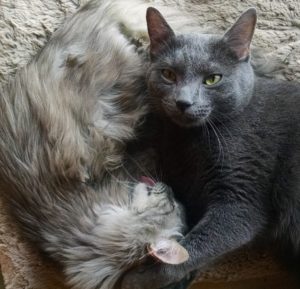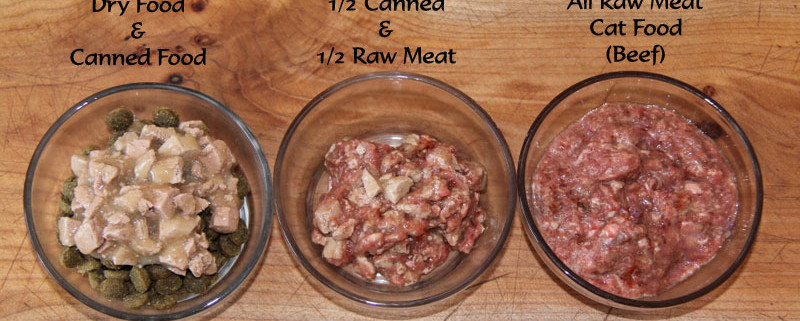There are many reasons why we foster cats here at The Happy Beast. The first is we simply love cats and will make any excuse to spend the entire day in their company. We also use the opportunity of fostering cats to indirectly help our customers. For instance, our experience in helping our IBS foster cats reinforced our drive to help get our cat customers off of kibble, and to eliminate it from the store completely by July 2016. (You can read more about that decision in this blog post.) Now for the update you’ve all been waiting for…

Dottie with her new friend.
We are happy to announce that Dottie was adopted in the beginning of April and is doing really well in her new home! Dottie was originally rescued from a cat hoarder by Almost Home Adoptions and had been living at the shelter for several years. She is missing her right hind paw and has IBS, so it took just the right family to come around and give her a home. Like most cats, she was a bit scared the first few days, but gradually came out of her shell and is now quite comfortable ruling the roost! Her new family is in love with her, which is exactly what she deserves, after many years of waiting for a home. We miss her dearly, but know that a quiet home environment is what is best for her and what will allow her to reach her highest potential.
Around the same time that Dottie was adopted, we acquired a new foster whose family needed a temporary guardian of their beloved cat, Carlos. He is a welcome addition to The Happy Beast family, very social and playful, and has really become the perfect companion for Fancy (who really enjoys the company of other cats). Carlos is a hardcore kibble addict and we have gone to great lengths to keep him from tearing open our bags of dog food. He is a high energy cat and his drive to break into dog food is likely due to boredom and his natural instinct to hunt. He just happens to be hunting dog food, instead of mice. A cat with this personality would really do best with safe outdoor access so he can climb trees and run around a yard. In the meantime, I take whatever down time I have to play with him, and his absolute favorite toy is the Go Cat Da Bird! Even Fancy likes to get in on the action. I try to play with the cats for 20 min 3 times per day in an effort to curb his naughty behaviors.
Fancy (our other IBS kitty) is doing great! Her stools finally began to solidify after 4 months of an exclusive raw diet. Quite frankly this is a miracle I thought we would never see. We think that she really likes having another cat to cuddle with. Fancy’s inclination for the company of other cats is nothing like I’ve ever seen in the 30 cats I’ve had in my life! Initially, she played hard to get with Carlos and would hiss at him when he would get too close. After a couple of weeks they were sleeping next to each other and next thing we knew, they were cleaning each other and spooning. However, Carlos’ kibble habits did have a negative effect on Fancy. Carlos tore open a bag and Fancy must have decided to take a couple of bites because the next day she had bad diarrhea and we had to give her a bath, which is basically like bathing a wild animal. She’s small but incredibly feisty and doesn’t like to be messed with. It took about a week to recover from this “kibble episode” but she’s back on track and continues to have nicely formed stool as long as she is on an exclusively raw diet.
Stop by the store to see them for yourself and let us know if you have any success stories of your own. For example, we just received a some great news from customers Melinda & Jon about their newest family member. These are the kinds of stories we live for. 🙂
We adopted a new kitten as a rescue who was under-nourished and neglected. At The Happy Beast we were supplied with information about the best foods for her. It has only been a few weeks and already we see much improvement in her temperament, her coat and her eyes. She is gaining weight and obviously feels much better.






